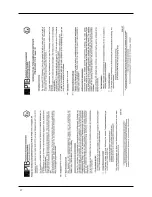
5
ENGLISH
If the pump is malfunctioning, part of the contents of the oil
reservoir could escape into the pumping medium.
Not Ex-pumps.
If a hose is used as a pressure line, care must
be taken to ensure that for every pumping operation the hose
is completely empty before the pump is submersed. Any resid-
ual liquid would obstruct the ventilation of the pump housing
and therefore also hinder the pumping operation.
This situation can also occur if the pump runs dry, pumps down
to a lower lever than that shown in the installation drawing, or
runs in "snore" mode during the daily test run.
SERVICING
We recommend that you service the equipment in accordance
with EN 12056-4 and EN 60074-19. To ensure continued reli-
ability of service, we recommend that you take out a service
contract.
WARNING!
Before carrying out any works: disconnect the pump and the
controls from the mains and take steps to ensure that it cannot
be emergized again.
WARNING!
Check the plug and the mains cable for signs of mechanical and
chemical damage. Damaged or kinked cables must be replaced.
NOTICE!
When using a chain to lift the pump, please observe
the relevant national regulations regarding accident preventi-
on. Lifting gear must be checked regularly by an expert in ac-
cordance with the legal regulations.
NOTICE!
Motors in the EX range conform to the "flameproof
enclosures" ignition protection category. Maintenance works
that affect the explosion protection may only be carried out by
authorised specialists or by the manufacturer. When carrying
out repairs, all areas next to flameproof gaps must be checked
for damages and, if necessary, replaced genuine parts.
Oil check
The oil reservoir is sealed on the outside with a sealing screw
"Öl" (oil). In order to check the mechanical seal, the oil, includ-
ing any residue, must be drained from the oil reservoir and col-
lected in a clean measuring container.
•
If the oil is contaminated with water (milky), an oil change
must be carried out. Check again after a further 300 operat-
ing hours, but at the very latest after 6 months!
•
However, if the oil is contaminated with both water and pol-
lutants, then not only the oil must be replaced, but the me-
chanical seal as well.
For monitoring the oil reservoir, it is also possible to retrofit
the electrode of our "DKG" or DKG-Ex" seal leak control device
in place of the "DKG" sealing screw.
Changing the oil
To ensure operational liability, the first oil change should be
carried out after 300 operating hours, with further oil changes
carried out after every 1000 operating hours.
If the number of operating hours is very low, an oil change
should still be carried out at least once a year.
If wastewater with strongly abrasive constituents is being
pumped, the oil changes should be carried out at correspond-
ingly shorter intervals.
Use HLP hydraulic mineral oil, viscosity class 22 to 46, e.g. Mo-
bil DTE 22, DTE 24, DTE 25, to replace the oil in the oil reservoir.
The volume of oil required is 520 cm³ for MultiCut 25/2 to 36/2,
750 cm³ for MultiCut 45/2 and 2600 cm for the MultiCut 75/2
und 76/2.
NOTICE!
The oil reservoir may only be filled with the specified
quantity of oil. Overfilling will result in the pump being rendered
inoperable.
Checking the pump unit
The housing screws for the pump, and the connecting and fix
-
ing screws of the installation must be checked to ensure they
are fixed securely. They should be tightened if necessary.
If the pump performance decreases, or if increasingly loud
noises can be heard during operation, or if the cutting perfor-
mance decreases (the pump tends to become blocked), the
impeller and cutting system must be checked for wear by an
expert and replaced if necessary.
Replace the impeller
CAUTION!
Worn impellers can have sharp edges.
1. Block the cutting rotor with a piece of wood and unscrew
the central hexagon socket screw
2. Unscrew the four hexagon socket screws on the top of the
spiral housing, and take off the spiral housing.
3. Fit the new impeller with the feather key onto the shaft,
using the same number of adjusting washers as before.
4. Measure dimension B on each blade and note the largest
measurement.
5. Measure dimension A in several places and note the smal-
lest measurement.
6.
Notice!
The impeller gap A-B must measure 0,5-0,7 mm.
If the gap is larger or smaller, use adjusting washers
(12x16x0.2) under the impeller to adjust the gap.
7. Screw the spiral housing and the oil reservoir/motor back
together again.
8.
As a final step, put the cutting rotor back on and adjust the
cutting gap.
Checking the cutting clearance
Using a suitable tool, e.g. feeler gauge, the cutting clearance
between the cutting rotor and the cutting plate can be meas-
ured. A cutting clearance of over 0.2 mm must be reduced.






































